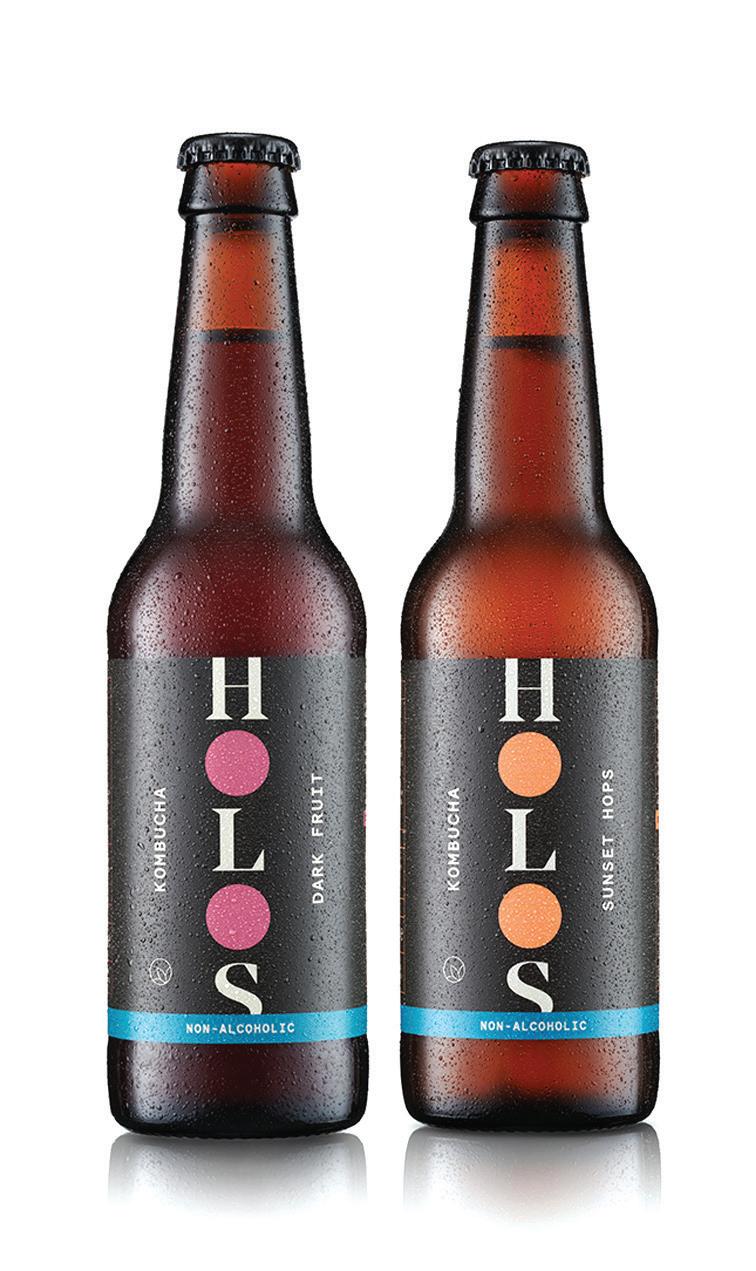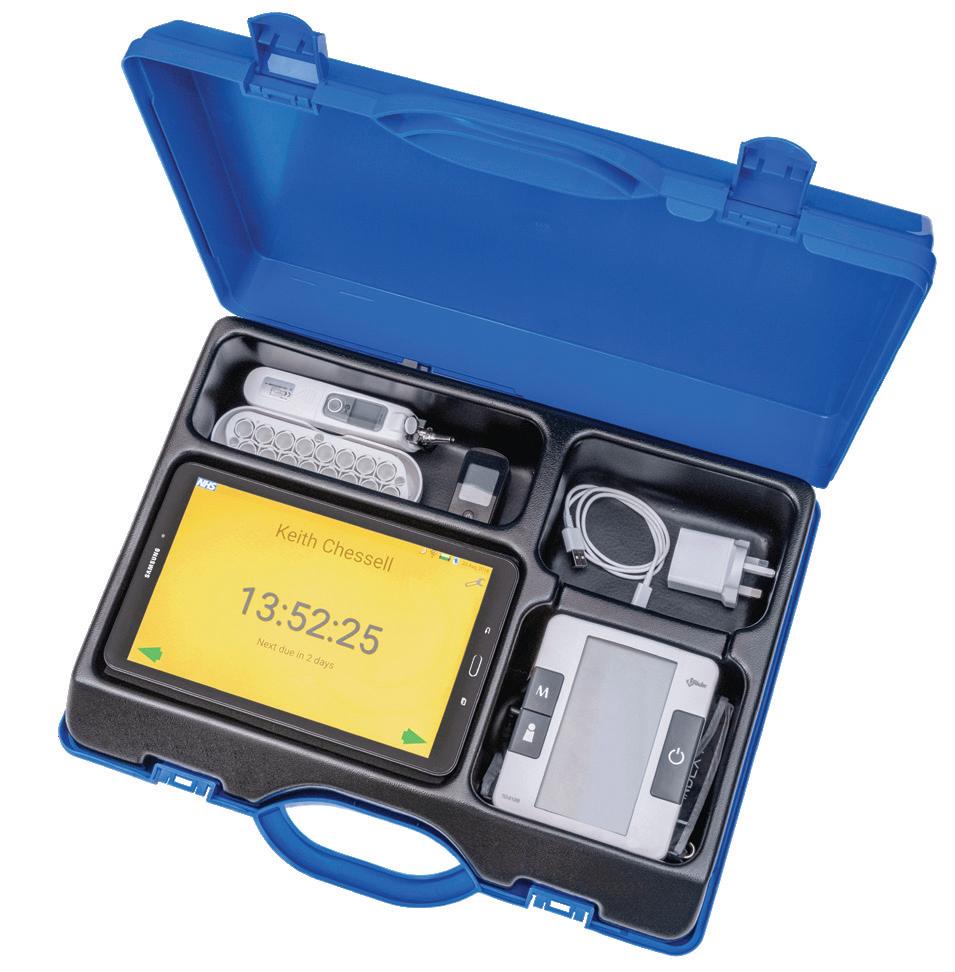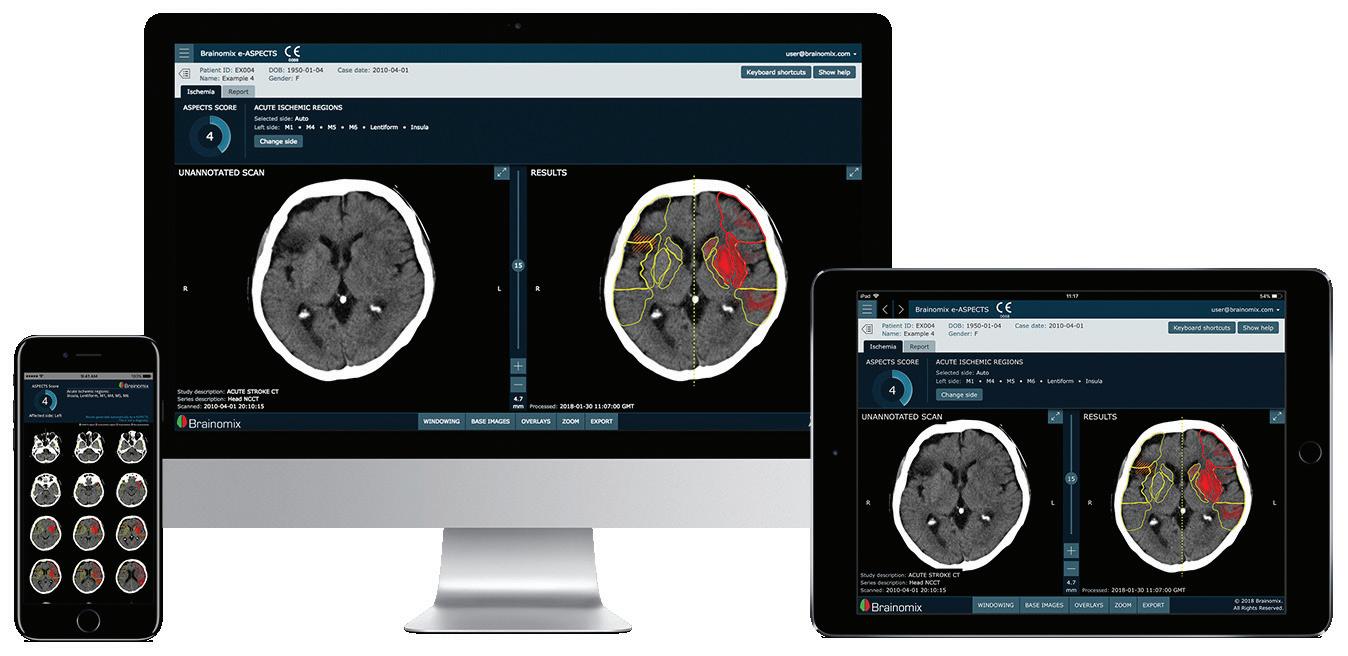
40 minute read
Cyber & Technology
Occuity co-founders CTO Dr Robin Taylor (left), and CEO Dr Dan Daly
OCCUITY FUNDING BOOST
Reading-based Medtech start-up Occuity has been awarded a £343,000 Innovate UK Biomedical Catalyst grant.
The grant will be used to continue development of the firm’s AGE reader, an optical medical device which will be able to screen for diabetes non-invasively, meaning it can be used in non-clinical settings like pharmacies and opticians.
Biomedical Catalyst, Innovate UK’s funding competition for health and life sciences SMEs in the UK, provides financial support to accelerate the route to commercialisation of innovative solutions to healthcare challenges. Currently, 422 million people in the world are affected by Type 2 diabetes, which has led to around 10 per cent of all government health spending being used to cover costs associated with complications relating to the disease. Occuity’s AGE reader measures the concentration of advanced glycation end-products in the eye, based on research which shows that these correlate to blood glucose levels, which can be measured to show a person’s risk of diabetes.
Dan Daly, CEO and co-founder of Occuity, said: “This grant will enable us to develop a benchtop device and to make a functioning meter to provide a route forward to a commercially viable product.”
The latest cohort of Content Guru graduates

Graduates key to Content Guru’s scaling ambitions
Content Guru has reiterated its commitment to graduate recruitment.
In 2022, this pledge saw the Bracknellbased business hire 76 graduates alongside more experienced professionals as it continues to scale.
In the same period, the company’s global workforce has grown by 20 per cent.
This brings the company’s number of employees past a record 400 with further growth expected across all of its offices in the next year.
Director Martin Taylor, said: “Graduates play a key role at Content Guru and hiring the best up-and-coming talent will remain an essential part of our mix as we continue our expansion.
“Career progression is highly valued at Content Guru and our graduate scheme provides dynamic, enthusiastic and agile graduates with an entry path into a full range of technology roles.”
Cyber firm C3IA Solutions appoint army specialist
A former army specialist has joined Poole cybersecurity business C3IA Solutions.
Iain Good, a Warrant Officer handling IT and cyber services with the Royal Signals, will join the business when his 24 years of military service comes to an end this year.
He will take up the role of Technical Services Manager for the firm which has 120 employees and contractors.
Iain said: “The company is very well known within the Royal Signals and although leaving the military after such a long time can be difficult, joining a company with such strong military connections should make it easier.”
What is the metaverse?

Everyone’s talking about the metaverse – but why should it matter to business? We find out
By Sam Pither, writer
The metaverse is a hot topic. What was once the remit of science fiction, such as in Ernest Cline’s 2011 novel Ready Player One, is increasingly becoming a realistic image of the future.
In October 2021, even the parent company of Facebook changed its name to Meta in reference to the developing technology.
But what is exactly is a metaverse? Is it the future of work, or a short-lived fad? And why is Mark Zuckerberg interested?
Firstly – what is the metaverse? According to Professor Yu Xiong of the University of Surrey, it is “an environment which enables people to interact with each other in the virtual world, similar to how they did in the real world”.
Currently, the two most popular environments are meetings and retail. Imagine a Zoom meeting, but instead of interacting through a tiny window, you sit and have a conversation in a virtual space, represented by an avatar.
This could, in turn, bring back the corridor conversation – the extra layer of social interaction which is arguably missed out when video calling.
Most of us have seen Meta’s offering, with its underwhelming graphical capabilities, and may struggle to visualise ourselves in it. As the technology progresses, however, it will gradually become truer to life.
If you’ve seen 2021’s spy action film The King’s Man, you will have an idea of the future possibility. One day, entering a virtual world could be as simple as putting on a pair of glasses and seeing the people in the meeting as if they were in the same room as you.
The other major application for business in the metaverse is retail, an area in which we are already seeing uptake among some of the biggest brands in the world.
For example, global luxury clothing brand Gucci has a space within Roblox, an online gaming platform which allows users to create their own games and virtual environments, as it looks to appeal to a younger generation.
The metaverse is moving retail into virtual stores
Going forward it is likely we will see increasing numbers of virtual stores, as Professor Xiong explained: “Many offline stores are moving to online spaces where all the objects inside the VR (virtual reality) shop are an online version of their real-life counterparts. VR allows customers to get a better feel for the actual size of an item, improving the customer experience.”
To make this possible, items in the virtual world must correspond to something in the real world. You may have heard of the blockchain and non-fungible tokens, or NFTs. A blockchain is a digital public ledger, which tracks the movement of virtual items or currency.
Blockchain integration gives objects in the metaverse a real-world value by ensuring anything traded is accurately recorded; giving to you is a loss from me.
An NFT is just a digital asset registered on said blockchain. It consists of a digital
file (such as an image or video) and an encrypted, immutable contract written in code, setting out the ownership and authenticity of the item.
To recap, a metaverse is a virtual world created through virtual reality, or VR. To give items within this virtual world a value, they are supplied with an encrypted contract as an NFT, and their movements are tracked through the blockchain.


While scepticism remains regarding the extent to which the metaverse will become integrated into everyday life, as the technology progresses it may well become an increasing part of technology we use to interact.
Last year, Maidenhead-based market insight firm Quocirca found that 68 per cent of IT decision-makers in the UK think AR/VR headsets will be used for virtual immersive workplace meetings within the next two years, while 61 per cent are already using at least one application of VR or AR.
AR (Augmented Reality) overlays the real world with virtual elements. In 2016 Pokemon Go took the world by storm, using people’s smartphone cameras to place virtual creatures into the world around them. It became one of the most used and profitable mobile apps that year and was downloaded more than 500 million times. It popularised location-based and AR technology and was even praised for promoting physical activity and helping local businesses grow as it boosted footfall in retail areas.
Metaverse technologies are being driven by Gen Z
Metaverse technologies are also being driven by Generation Z. That same Quocirca survey found 73 per cent of IT decisions-makers aged between 18-34 expect AR or VR to be used for virtual meetings in the next two years, compared to only 53 per cent of decision makers aged 45 or over.
One of the biggest questions surrounding the metaverse is that of integration, with some suggesting that too many different offerings with different ways of working (in some metaverses, a user can trade with real world currency, whereas in another they are limited to cryptocurrency, such as bitcoin) will limit its uptake in general life.
Professor Xiong sees this as more a question of technology: “Before we developed transportation infrastructure, people lived their entire lives in one city. Once you have the standard in place, like a highway with the cost covered, the world starts to open up.”
Whatever your view, the metaverse – in one form or another, is coming, and is likely to become an increasingly normal part of life. The question business owners should be asking themselves is, “who are my customers, and are they likely to use the metaverse?”
With Bloomberg suggesting the metaverse could be an $800 billion market within the next few years, it’s clear why Facebook founder Mark Zuckerberg is so interested.
LOOKING TO GROW YOUR BRAND?

Using the power of communication to help you reach new audiences


Houston PR is an integrated team of communications experts, specialising in consumer media relations, influencer marketing, corporate, social and content creation. Our hospitality, food and drinks division work with globally renowned brands as well as start-ups and challenger brands, and have orchestrated high-profile media campaigns that have been key in driving awareness and impactful engagements with audiences.
We craft creative, memorable campaigns through our understanding of the consumer market. It’s a complex crowded sector, but our expertise, creativity, and passion will help you cut through the noise. Specialising in food and drink, lifestyle, interiors, corporate and capital markets as well as digital and web design divisions, our talented team is always on call to find the most effective ways of making your message stand out. Whether you’re a big global brand or a local family-run start up, our approach is the same.
To us you’re a partner, not a project. We become an extension of your team as we believe in collaboration and that communication is a never-ending conversation. This approach is our foundation, our strategic cornerstone, and it’s the reason we’re proud collaborators with some of the best brands in the industry.
If you’re embarking on a new launch and are looking for a trusted partner to work with, we are here to help. If you’d like to hear more please get in touch with our team.
TEN INSPIRING PRODUCERS
Our pick of the innovative food and drink makers that are making their mark on the South East
By Sam Pither, writer
What makes food and drink cool?
Sometimes it’s the journey that the founders and their product have been on and other times it is the overall vision.
In business, we focus a lot on output. Whether making sales or giving advice, success is often measured by what we put into the world.
Less considered, but no less important, is what we put into our bodies – the fuel which drives our success.
Whether it is a quick lunchbreak snack or a drink in the evening to unwind, quality food and drink is conducive to quality work.
In this list we have bought together cool food and drink which stands out from the crowd. With more choice than ever, cool food and drink needs to have a strong brand identity, whether that comes from the packaging or the way a business interacts with its local area.
Beacon Down vineyard in East Sussex offers customers the chance to rent an entire vine from which they can pick the grapes in autumn, while Kent’s Cantium Gin has a unique bottle which is great for the planet too.
The Tomato Stall capitalises on the Isle of Wight’s climate to produce a range of exotic tomatoes delivered straight to your door while Jude’s Ice Cream powers its entire dairy with renewable energy sources and has donated a quarter of a million pounds to local charities.
Like a good team is the sum of its constituent parts, good food and drink comes from good ingredients, assembled in a nurturing and caring environment and reinforced by a passion for the product.
Beacon Down owners Paul and Al Pippard
OWN A VINE

BEACON DOWN, East Sussex
Many of us have given a bottle of wine as a gift, but how many of us have given an entire vine? Beacon Down does exactly that, by leasing out the vines in its vineyard for a year. Leasing a vine for a year gets you a bottle of wine, a tour of the vineyard with a tasting session and the chance to pick the grapes from your vine in the autumn. A unique experience putting you in the shoes of a sommelier.

Cantium Gin has reimagined the traditional gin bottle

HOLOS KOMBUCHA, West Sussex
HOLOS Kombucha has a cool product and an even cooler ethos. Its kombucha is low-sugar and good for your gut, made in a small batch and is unpasteurised. The company is working towards organic, gluten-free and vegan certification.
Holos also works with charities to provide accommodation, counselling and casework support for survivors of slavery, trauma and human-trafficking as well as offering employment to survivors of slavery to help them get their lives back together. Back in 2018, it set aside 25 per cent of the original founders’ shares to create the HOLOS Foundation which carries out its charitable work. Cantium Gin puts its local connection front and centre, taking its name from the Roman name for Kent. Cantium also make a point of using local ingredients as much as possible, sourcing botanicals including apple, blackberry, hops and roasted chestnuts from their local area.

If this wasn’t enough, the gin is packaged in a striking metal flask. This is to make the bottles reusable, extending the lifecycle of the materials. Ir also helps to keep your drink at the perfect temperature as you go about your daily life, making it ready whenever you fancy a tipple.
Holos fights human slavery through its foundation

Pished Fish will be the talk of any dinner party

James Eagle of Pished Fish THE PISHED FISH, East Sussex

What do Selfridges, Fortnum & Mason and your house have in common? They can all receive booze-infused smoked salmon from The Pished Fish. Sourced from Billingsgate Fish Market, The Pished Fish’s alcoholic aquarians range from The Augustus Gloop with Raspberry Vodka & Blueberries to the Uncle Sam Roasted Salmon Fillet with Honey & Bourbon.
After the pandemic hit, the company switched focus to online sales, selling direct to customers in a method reminiscent of its market stall roots – without having to worry about the weather.

Hampshire Cheese relies on traditional methods
HAMPSHIRE CHEESE COMPANY
When Hampshire Cheese Company says its ingredients are sourced locally, it means it. The company produces its Tunworth and Winslade soft cheeses using milk collected every morning from an estate only a few miles from its creamery. Over the next seven to eight weeks the cheeses are slowly ripened by traditional methods similar to those used in Normandy, with every stage of the process carried out by hand.


RENEGADE BREWERY, Berkshire
Established in 1995, Renegade (formerly West Berkshire) Brewery produces a range of strikingly packaged beers. The brand’s Solo Alcohol-Free Peach Pale is particularly cool, featuring all the great taste of a pale ale without the hangover on the next day.

The brewery is also well-invested in its local area, having produced a 150th Anniversary beer for Reading Football Club in 2021. Fans of the club will recognise the brewery from its concession outside the Sir John Madejski Stand.
Renegade Brewery’s Solo Alcohol-Free Peach Ale has been well received
The Tomato Stall takes advantage of the sunshine on the Isle of Wight
THE TOMATO STALL, Isle of Wight
Sometimes being cool is a case of making the most of your environment and this is true for The Tomato Stall. Capitalising on the fact the Isle of Wight is one of the sunniest places in the UK, the brand produces a variety of different tomatoes and aubergines between March and November, all picked to order. This is when it also makes its range of sauces and chutneys which are sold throughout the year.

Putting sustainability at the forefront, The Tomato Stall recycles plants as compost and rainwater as irrigation, living up to the ethos of “zero waste, maximum taste”.

Jude’s dairy is fully powered by renewable energy JUDE’S ICE CREAM, Hampshire

Not many food producers can boast B Corp certification, showing their commitment to making the world a better place, but Jude’s can. Having already reduced its carbon intensity by 20 per cent since 2020, Jude’s is committed to reducing it by 43 per cent by 2030. The dairy is fully powered by renewable energy, with solar panels fitted on its largest buildings.
Jude’s has also donated more than £250,000 to charities supporting children and young people in the local area, and gives as much surplus stock as it can to local charities and food banks. It also makes a great range of Vegan ice creams.
THE KENT DARK CHOCOLATE COMPANY, Kent
Kent is known for a lot of things, but chocolate isn’t necessarily one of them. That is no fault of the Kent Dark Chocolate Company, however, which makes luxury chocolate from carefully sourced, organic cocoa beans in its Folkestone factory.

Along with putting Kent on the chocolatier map, the company supports local charities KSAR Kent Search and Rescue, Headway East Kent (which supports adults with an acquired head injury and their families) and Last Chance Animal Rescue.
Kent Dark Chocolate carefully sources its ingredients

The British Honey Company is working to support British bees
THE BRITISH HONEY COMPANY, Oxfordshire

The British Honey Company produces a range of honeys, jams and honey-infused spirits. Its production facility is capable of producing approximately 1.5 million bottles per year and the company has developed software which allows it to trace single ingredients through to individual bottles of spirits or jars of honey.
Along with tasting great, buying British honey supports British beekeepers who, in turn, help to nurture Britain’s bee population. Considering more than 75 per cent of the world’s crops rely on pollinators, we think that is very cool.

LEVERAGING TAX, TALENT AND FUNDING OPPORTUNITIES FOR HEALTHTECH BUSINESSES

The accountants, tax and business adviser MHA MacIntyre Hudson keeps its finger on the pulse to support the healthcare technology sector, as Jason Mitchell, Partner and the firm’s Head of Technology, explains.
Jason Mitchell
The Covid-19 pandemic and its rapid vaccine rollout brought HealthTech further into the spotlight, particularly the use of technology to speed up the development of new drugs and treatments. For businesses in the sector, huge rewards are usually the result of taking enormous financial risks, often taken during the early stages of milestone breakthroughs.
While HealthTech companies grab the headlines with their success stories there is plenty of hard graft from others going on almost unnoticed behind the scenes. Accountants and tax specialists, for example, ensure vital corporate life support opportunities, like funding, talent retention and tax breaks are maximised.
MHA supports a broad spectrum of HealthTech clients, including medical technology, pharmaceutical and life sciences businesses. These range from small start-ups and mid-sized businesses to the UK-based subsidiaries of large multinational parent companies.
The firm has a 13-strong national team covering the sector comprising specialists in tax, audit, funding, and employee benefits, with offices in Maidenhead, the Thames Valley, London, the South East, Midlands and North West. As an independent member of the Baker Tilly International (BTI) business advisory network, it works closely with experts from the US to India and across Europe, notably Belgium, Germany, and the Netherlands, where Life Science Industry is well established and pioneering.
KEY CHALLENGES IN THE SECTOR INCLUDE:
Innovative funding options
Many companies are keen to seek funding outside the usual traditional sources, for example, through crowdfunding. These platforms can provide important access to essential funding for younger businesses that are still developing their technologies.
Accessing funds directly from customers is also increasingly evident in the sector. This is more likely when a company is developing products specifically for one or two major customers, who have funds available to invest plus a vested interest in achieving a successful outcome.
Occuity Pachymeter In inductive charging cradle
A recent example is Reading-based Occuity, the 2022 Thames Valley Tech Awards’ Start-Up of the Year, who MHA has worked with for several years. The company’s product, a non-contact handheld pachymeter, screens for diabetes and the business has grown from two to nearly 40 people in just a few years.
Grant income opportunities
The availability of grant income as a form of funding can often be overlooked but can provide a significant financial boost. MHA has strategic partnerships with specialists who monitor the availability of grants and help businesses through complex application processes. One of the best-known providers of grant funding and loans is Innovate UK, which is part of UK Research and Innovation but there are many other less publicised grants available to support specific projects.
Navigating R&D tax credits
Applying for Research and Development (R&D) tax credits can be a bit of a minefield, but it is worth the effort to access the major financial incentives offered by the Government to innovators. Small and medium-sized companies with fewer than 500 employees and annual turnover below €100 million or a balance sheet under €86 million can claim the relief. It allows a 130% deduction of their qualifying costs from their annual profit in addition to the normal 100% deduction – giving a 230% benefit in total! However, from 1 April 2023, the 130% rate will be reduced to 86%, so companies that are interested in receiving the relief should act now.
Although the amount of R&D tax relief provided by the Government fell 4% to £6.6 billion in 2020/21 (in part, as a result of the Covid-19 pandemic), the number of claims rose 7% to 89,300, driven by an increasing number of claims from small and medium-sized companies.
In the R&D world, businesses need to keep up-to-date with changing HMRC rules, for example, UK-based HealthTech companies with overseas development teams may find not all of their costs are eligible, while a wider range of cloud computing costs are now becoming eligible for tax relief.
Managing transfer pricing
Transfer pricing is the accounting practice used by multinational companies to show the profits delivered by their subsidiaries in different countries depending on the commercial role of that subsidiary. Many HealthTech companies are global with operations in the UK, where crossborder transactions between operating companies can have a significant impact on the tax they pay, particularly as each country’s tax authority will potentially challenge whether the level of profitability reported is a fair reflection of the commercial activity in their territory.
Tax authorities are keen that tax is fairly apportioned and so the rules on what has to be paid and where are complex. HealthTech companies need to have a clear understanding of what each of their business units does and how they account for their profits to avoid falling foul of local tax laws. For example, companies operating on both sides of the Atlantic should keep abreast of changes in both IRS and HMRC regulations.
On 19 January, the firm will be hosting a free one-hour webinar – The Baker Tilly International Life Sciences Forum. This will be a panel discussion covering the compliance, tax and legal considerations for HealthTech businesses that are exploring investing in the UK or expanding cross border outside the UK. To register, email Andrea.Holmes@mhllp.co.uk.

Incentivising top talent
Behind every technological breakthrough are highly skilled and dedicated people. Like the technology sector in general, in HeathTech the top brains are in relatively short supply, so the fight to attract and retain the most talented employees is intense.
A company’s ability to hold on to its talent often centres on offering enticing remuneration packages. MHA MacIntyre Hudson’s dedicated team specialising in remuneration planning advises on a wide range of tax reliefs and share option schemes. For example, governmentbacked employee share schemes with tax advantages include share incentive plans, company share option plans and enterprise management incentives. Rewards to incentivise and boost employee loyalty are typically structured around performance milestones or positive share price movements.
ESG focus
Given the nature of what they do, HealthTech businesses have to be in tune with the latest ESG priorities. After all, their products and services deliver important public and environmental health benefits. It is important that businesses demonstrate their adherence to ESG, from supporting employees and communities to the rigorous assessment of companies in their supply chain.
MHA has years of experience advising clients on regulatory ESG disclosure requirements. For those corporates large enough to be directly impacted by the legislation relating to disclosure of policies, it conducts extensive ESG assessments during the usual financial audit cycle to help make sure clients know what they need to do and act in the right way.
Post-Brexit and globalisation
While many of the duty and VAT uncertainties surrounding Brexit have now largely been understood and tackled by businesses, the UK’s departure from the European Union still poses challenges for the cross-border movement of goods and people. The firm has been highly active in this area for healthcare sector clients.
In addition, its membership of BTI gives the firm access to a wealth of experience, especially from the US, in international drug and research development activity.
HEALTHTECH IS IMPROVING HEALTHCARE AND SAVING LIVES

Applying technology to healthcare is improving the quality of healthcare delivery, increasing patient safety and reducing medical errors. We look at the regional healthtech landscape and how it’s helping to save lives
by Nicky Godding, Print Editor
The Covid 19 pandemic saw investment in healthtech soar, but as most of the world (excluding perhaps China), returns to a post-Covid life, that investment is falling.
Healthtech funding in the second quarter of 2022 reached $11 billion, down 13 per cent compared to the previous quarter and down 47 per cent on the second quarter of 2021.
The figures, published by Dealroom, the global data platform for intelligence on start-ups, innovation and high-growth companies, also revealed that while drug development with artificial intelligence (AI) was the most funded segment, other segments such as telemedicine and mental health have slowed down. However, across the UK, healthtech is still the largest employer in the life sciences sector, employing 268,000 people across 6,630 companies, of which 85 per cent are SMEs, with a combined turnover of £89 billion, according to the government, and half of all life sciences jobs are located outside of London and the South East.
The UK is the third largest market for venture capital investment into healthtech at $3.8 billion, behind the US at $31.9 billion and hot on the heels of China, according to Regent Assay, the West Midlands-based corporate finance advisers.
The “golden triangle” of London, Oxford and Cambridge are driving much of the UK growth in life sciences, attracting $5.7 billion of investment between 2016 and 2021, a quarter of European healthtech investment and 65 per cent of the UK’s in the period.
However, the vast majority of UK healthtech companies employ fewer than 250 staff according to the Association of British Healthtech Industries.
What is healthtech?
Companies active in the healthtech sector include those developing and commercialising any technologyenabled healthcare product or service which can be deployed in or out of a hospital, surgery or care environment.

The Isansys Patient Status Engine (PSE) which frees up clinical time without reducing patient monitoring
HEALTHTECH’S FRONTLINE IMPACT

More than 16 million repeat prescriptions were ordered via the NHS App in the last year.
Throughout the pandemic, use of the NHS App rapidly increased and NHS Digital (the UK’s health and social care information centre) revealed that from June 2021 – May 2022, 1.3 million GP appointments were booked, GP records were viewed more than 90 million times and 277,000 organ donation decisions were registered.
The NHS App has recorded more than 28 million sign-ups, with more than 22 million new registrations in the last year. More than 24 million of these have fully verified their identity through NHS login. This means they can now access a variety of digital healthcare services quickly and securely through the NHS App.
This digital technology is available to us all, but there are hundreds more healthtech innovations being developed across the region already providing real benefits to those with specific needs and illnesses. The Patient Status Engine (PSE), developed by Oxford-based Isansys, is a wireless platform that captures and analyses patient data such as heart rate, temperature, blood saturation, blood pressure and electrocardiogram (ECG) in real-time.
This data, along with an early warning score, is fed live to a central monitoring station for clinicians and nurses and can even be viewed on their mobile phones. It allows care teams to proactively offer treatment and avoid emergencies.
The PSE has been approved for use in the UK, United States and Europe. It can also be used to monitor patients wirelessly and remotely in hospital or at home without compromising on the level of care they receive.
Then there’s OrganOx, also based in Oxford, which is saving lives by increasing the number of livers transplanted.
Since the first successful liver transplant was done in 1967, experienced surgeons have had to decide whether to use a donated liver largely by visual and physical assessment alone.
In the heat of the moment, with the patient often in the operating theatre, there’s no time for detailed analysis before transplantation and the surgeon will always err on the side of caution. If they deem a donated liver is marginal, it will be rejected.
OrganOx’s metra device gives surgeons the time and means to assess the quality of the liver before transplantation takes place, and allows a liver to be transplanted at body temperature.
Put simply, the device mimics the human body’s impact on the liver and keeps the organ at a steady 37°C while supplying the liver with oxygenated blood, anti-clotting drugs and nutrients to keep it healthy.
To date the OrganOx metra has supported more than 1,500 liver transplants worldwide.


COLLABORATION IS HEALTHTECH’S BEATING HEART

Two innovative university-driven projects have shown what can be achieved when academia, industry and the public sector come together
by Stephen Emerson, Managing Editor
Technology and health are not always the easiest of bedfellows with several hurdles to be overcome before the two can successfully come together to provide patient and economic benefit.
This friction between the two, created by innovation and risk, can be addressed through collaboration. And a number of successful models of university and industry co-operation exist across the region.
Oxford Healthtech Labs and the Portsmouthbased Supporting Innovation and Growth in Healthcare Technologies (SIGHT) programme provide examples of successful collaboration in action, with each having a different approach when it comes to acting as a bridge for private enterprise and healthcare.
Oxford Healthtech Labs was founded to build on the University of Oxford’s strong reputation for healthcare and technology with a focus on embedding teams from a range of academic disciplines within healthcare settings. The SIGHT programme, which strives to engage SMEs with the healthcare system, is a collaboration between the University of Portsmouth, Portsmouth Hospitals University NHS Trust and the Wessex Clinical Research Network.
The £1.7 million programme, part-funded by the European Regional Development Fund (ERDF), ends in mid-2023. The university and the NHS Trust are not only continuing the programme but aim to extend it to offer support previously excluded by ERDF restrictions.
UK healthtech industry worth $20 billion to UK economy
The UK healthtech industry is growing at a rapid pace. In 2022, it was worth $20 billion to the UK economy, with the sector expected to be worth $25 billion in 2027. Around 23 per cent of the industry is based in the south of England, which equates to close to 600 companies.
Professor Jeroen Bergmann, Director of Oxford Healthtech Labs
Professor Jeroen Bergmann, Director of Oxford Healthtech Labs, works with healthtech companies of all sizes. His organisation helps to de-risk healthtech products and propositions.
“We put a team together and immerse them within a healthcare setting and let them find and observe problems that may normally get overlooked, he said.
“The team is multi-disciplinary and could be made up of engineers, clinicians, mathematicians and businesspeople who will go in and observe what the problems and needs are.
“Once these have been identified, they then rank the needs based on the commercial potential of that need and what the market size is.
“It is a needs-led innovation approach that creates a better market fit and asks if the right problem is being focused on or if there is an underlying problem at play.”
Dr David Lubega, Research and Innovation Collaborations Manager at the University of Portsmouth, supports the SIGHT programme. He said that his organisation opens doors for technology companies looking to move into the healthtech sector
He said: “It allows the healthcare sector to access ground-breaking technologies and helps companies become more aware of the challenges around product development in a healthcare setting.
“A lot of companies come into this sector which have been very active in other technologies and they are now trying to bring effective tools into the healthcare sector.”

The University of Portsmouth plays a pivotal rule in the SIGHT programme

Dr David Lubega, Research and Innovation Collaborations Manager at SIGHT

Universities play a linchpin role by bringing together companies and healthcare providers. However they also bring academic rigour and new strands of thinking not found in the corporate world.
Professor Bergmann said the healthtech industry was built around collaboration because without it, or if it is reduced, then products are produced which are not fit for purpose.
“Healthtech is not possible without collaboration because it’s all about stakeholder engagement, he said.
“If you are trying to create an impact within a healthcare space then you have to talk to the clinicians, healthcare providers and patient groups.
“If you don’t do this then you might develop technology which isn’t fit for purpose, won’t be of interest to the hospital or the patients, or you won’t be able to get regulatory approval because of issues with compliance.
“You have to engage with a broad group of users and stakeholders and also those who have an influence over the process such as policymakers.”
Dr Lubega said collaboration helped de-risk innovations in the sector and drive forward technological advancements.
He said: “SIGHT allows for pre-competitive research and development and underpins new developments in the healthtech sector. Collaboration allows companies to gain access to cutting edge technology and talent, which brings societal benefit as it brings on stream previously unimaginable advances.
“Academics are very good at identifying problems and companies are good at tackling the issues and putting ideas into practice.
“This approach has benefits for company performance and is a great way to de-risk research and development investment, especially for companies that have not been involved in this regulatory environment before.”
Oxford Healthtech spin-out develops bedside monitoring for asthmatics
Albus Health emerged from the Oxford Healthtech Labs programme and is a strong example of academic and industry collaboration.
The company started out by observing patients in hospitals who suffered from asthma and saw that many sufferers do not notice or react to a deterioration in their condition until it is too late for medication to make a difference.
Albus Health deduced from its observations that an app, which patients used to monitor their own condition, would be ineffective because patients did not appreciate the current severity of their illness.
The company developed a bedside monitoring system to keep track of a patient’s breathing and alert health professionals early enough to prevent hospitalisation.
It also sparked another insight which showed that patients’ asthma symptoms at night were clearer.
Armed with these two insights, and an appreciation that getting a standalone product in this field regulated was a lengthy process, Albus Health decided to work with a pharma company that was creating medication for asthma patients.
This technology is now being used to monitor the effect that medication is having on patients – getting data on how patients respond overnight has traditionally proved very difficult to access.
Professor Bergmann said: “Within a couple of years, Albus Health went from being formed, to developing a system which it was then able to sell into the pharmaceutical industry.
“It is a good success example which shows a clear need identified, having the technology that fits and a deeptech company which has thought about the route to market.”

TEN HEALTHTECH FIRMS TO WATCH
Advances in hardware and software are accelerating the detection, management and treatment of life-limiting illnesses. We look at the companies in the South East that are at the vanguard of improving health through technology
OCCUITY, READING
The potential of our eyes as an indicator of our health is increasingly being understood and Reading-based Occuity is making its mark in this area through a number of innovative devices.

Occuity’s handheld devices are non-contact and show that changes within the eye can be used to detect and monitor diseases. The company is working on optical instruments that will track and monitor the progression of conditions including myopia (short-sightedness), glaucoma, diabetes and Alzheimer’s.
The Occuity PM1 pachymeter which diagnoses glaucoma
Cough patterns can be used to flag developing respiratory diseases
QUVIUM, RAMSGATE

Kent-based Quvium’s wearable SONASURE analyses a patient’s cough and determines patterns that could signal respiratory diseases.
It notifies healthcare practitioners when changes in cough frequency occur which could signify a new infection or deterioration of an existing condition.
This can enable earlier medical intervention and reduces respiratory attacks, unnecessary A&E visits, hospitalisations and irreversible damage to lungs.

ACTEGY HEALTH, BRACKNELL
Bracknell-based Actegy Health’s Revitive Circulation Booster devices aim to boost circulation using its OxyWave electric muscle stimulation technology. This drives oxygenated blood to the legs and feet which can relieve leg aches as well as reducing swollen feet and ankles.
More than three million Revitive Circulation Boosters have been sold around the world.

OXEHEALTH, OXFORD
Oxehealth’s Oxevision is a contact-free patient monitoring system that can be used to remotely measure vital signs (pulse and breathing rate) via an infrared-sensitive camera installed in a patient’s room. The system also delivers activity insights to clinicians, which can enable them to intervene proactively when a patient may need help.
The Oxford company’s system measures breathing rate through chest wall movements and pulse through colour changes in the skin that are undetectable to the naked eye. The latter mechanism resembles a pulse oximeter, which is widely used in healthcare but must be attached to a patient’s skin.
The system is primarily used in mental health inpatient settings, where there is a clear advantage to having contact-free physical health monitoring. Its activity tracking software can also be used to identify high-risk situations (such as a patient spending a prolonged period of time in their ensuite bathroom, which may indicate a self-harm risk; or an elderly patient getting out of bed, which may indicate a falls risk) so that staff can attend and try to prevent incidents from occurring.

The Oxevision platform can remotely monitor patients
ShareMyXray is driving forward the digitisation of X-rays

SHAREMYXRAY, SOUTHAMPTON
ShareMyXray started in hospitals to allow sharing of images between institutions. It has broadened its service to patients by developing an offering that allows people who have undergone an X-ray to receive their results via an online portal. The Hampshire company uses militarygrade encryption to secure patient details and its technology could spell the end of X-rays being delivered through the post on CDs.

OXSIGHT, OXFORD
Customer quotes on the OXSIGHT website reveal details of users being able to see their mum’s face for the first time in 10 years. They encapsulate the power of sight and the human connections that we lose when our vision starts to fade.
Oxford-based OXSIGHT has two products which aim to restore a loss of sight that are billed as affordable, usable and wearable.
Its Crystal smart glasses use an HD camera to stream live video feeds into two compact projectors that target the usable areas of the eye and restore a wide field of vision. The firm’s Onyx glasses automatically detects objects using autofocusing lenses to adjust accordingly to enhance their users’ vision.

LIFELIGHT FROM XIM, SOUTHAMPTON
When the first advanced smartphones appeared over a decade ago few could have predicted the positive impact they would eventually have on our health.
Southampton-based Lifelight from xim is the epitome of this advancement and its technology has the potential to radically change how primary healthcare works in the UK and further afield.
A patient simply needs to look into their smartphone for 40 seconds and their blood pressure, pulse and breathing rate are recorded and sent back to a health specialist.

GLUCORX, GUILDFORD
Surrey-based GlucoRx has developed the world’s first multi-sensor non-invasive continuous glucose monitor which could free diabetes patients from having to use needles to monitor their condition.
Currently, patients have to prick their finger to extract and test their blood several times a day using glucometers or apply semi-invasive devices such as continuous blood glucose monitors.

The GlucoRx BioXensor uses radio frequency technology alongside a multiple sensor approach to measure blood glucose levels every minute and is effective as an early intervention tool.
GlucoRx’s device could mean less needles for diabetes patients
Solcom allows remote monitoring of patients

SOLCOM, RYDE
Solcom builds software and creates hardware that integrates with healthcare and patient record systems.
The Isle of Wight company’s Whzan Digital Health suite of products uses remote technology to allow monitoring of patients by their families, carers and health specialists.
Whzan’s all-in-one telehealth case – The Blue Box – measures vital signs, records photos and performs multiple assessments to monitor changes to health while the Guardian hardware and system is Whzan’s home sensor monitoring system which helps vulnerable people live in their own homes for longer.
WhzApp is a mobile app which allows clinicians to connect with patients and manage their conditions remotely through self-assessment while patients’ vital health indicators can also be monitored.
BRAINOMIX, OXFORD
Brainomix’s software is being used to improve stroke treatment
Oxford-based Brainomix specialises in the creation of AI-powered software solutions to enable precision medicine for better treatment decisions in stroke, lung fibrosis and cancer. Brainomix’s e-Stroke software is a collection of tools which uses AI algorithms to provide doctors with real-time interpretations of brain scans, guiding treatment in healthcare systems around the world.


Reaction Engines takes off with zero-carbon breakthrough

For the 2022 Thames Valley Tech Awards double winner Reaction Engines, space-age innovation has earthbound applications.
Tom Burvill, Director of Applied Technologies

Reaction Engines, the company judged to have the Thames Valley’s most sustainable and most innovative technology for its transformative breakthroughs, readily acknowledges the benefits of winning these endorsements.
Tom Burvill, Director for Applied Technologies, said: “Winning awards helps with our recruitment by attracting talent, while demonstrating to customers and investors that our technology is benchmarked against other companies in the region.”
Driving past Culham Science Park in Oxfordshire, you might not notice that behind the gates, two key technologies are being developed that could radically shape our lives in the future. Reaction Engines, which is developing pioneering thermal management technology capable of transforming the aerospace industry and accelerating zero-carbon aviation, shares the wider Culham site with the UK’s nuclear fusion energy research programme. Reaction Engines was formed in 1989 by the ‘three rocketeers’ – Alan Bond, Richard Varvill and John Scott-Scott, engineers keen to develop propulsion for space access. The company has grown to over 230 staff and has a second site near Denver, Colorado. A mix of investment and self-funding plus the commercialisation of its innovations are driving growth for the company. “We aim to keep growing, to address our customer demand,” said Burvill. “In the last five years, we’ve been commercialising our space technology to grow revenue and our customer base.”
Reaction Engines continues to pioneer its high-speed air-breathing propulsion systems, a radically more efficient alternative to traditional vertical take-off rockets with parallel applications in highspeed flight within the atmosphere.
While the technology to reach space is still in development, Reaction Engines is concurrently focusing on high-efficiency heat exchangers for reducing carbon emissions across a range of industries including aerospace, automotive and energy.
The initial target is smaller aircraft – ‘Project Fresson’ – the conversion of a Britten-Norman Islander nine-seat aircraft from conventional fossil fuel to gaseous hydrogen propulsion. This development is set to deliver the world’s first fully certified, truly green, passengercarrying aircraft using hydrogen fuel cell technology. Led by Cranfield Aerospace Solutions, Project Fresson will deliver emissions-free commercial air travel and is planning for test flights starting later in 2023 and to be certified for passenger flight in 2026. As specific designs for zero carbon emission planes come off the drawing board, the technology will be scaled up for larger aircraft.
Another imminent transformation is zero-carbon fuel cells in vehicles as a lighter alternative to battery power, but this needs to be enabled by the refuelling infrastructure. “The compactness of hydrogen fuel cell systems is important. Hydrogen-fuelled motor racing could be here as soon as 2025,” Burvill predicted.
The company also supports electric vehicle developments for cars and planes. “We are working on battery pack thermal management for uniform battery temperatures, higher performance, longer life and faster charging,” he added.
Other partners include BAE Systems, Boeing and Rolls-Royce. Out in space, Reaction Engines sees market potential in practical applications that could be unlocked by reusable reliable launch systems, including debris removal, Space solar power and even asteroid mining. Sustainability has never been more exciting.









